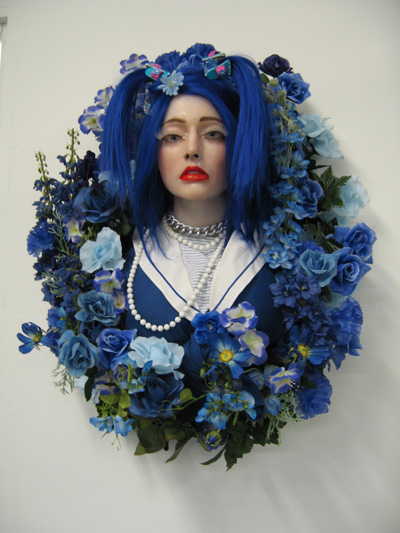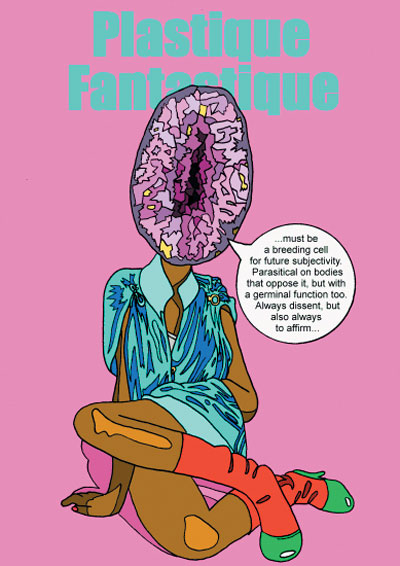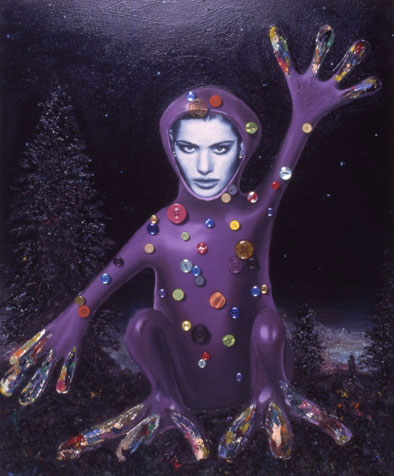|
Multiverse :
Jemima and Dolly Brown, Ole Hagen, Alicia Paz and Plastique Fantastique (by David Burrows and Simon O’Sullivan) |
|||
 |
|||
|
Jemima and Dolly Brown Michael's (Alig) Sailor Moon Daisy 2007 |
|||
|
26 June- 26 July 2009 |
|||
|
Multiverse brings together artists who use fiction to access the virtual potential for multiple co-existing worlds. The term multiverse, first coined by William James, has become associated with quantum theory and new cosmology. Applied to the universe it implies that there could be an infinite number of universes decohered from each other. It also operates in relation to the idea of a multidimensional hyperspace. The scientific future of the term might be uncertain, but it can describe a radical way of considering fiction. With respect to the potential existence of a number of possible worlds, our own physical world is just a freak possibility. Following this line of thought, fictional realities are downloaded from the multi-virtual rather than invented. Imagination is then no longer a private faculty, but a transpersonal way of accessing alternative modes of subjectivity. For each specific medium of the artwork there are laws of coherence of a relative autonomy. But in each work of Multiverse there is also the presence of alien forces. In a multiverse both brimful of consciousness and dissymmetry there is the potential for parallels, correspondences and synchronicity as well as fragmentation, disunity and obfuscation. Fiction must employ the imagination to probe the proliferation of worlds just at the point of formation to fulfil its role as a medium for other possible realities. Jemima and Dolly Brown bring into being humanoid avatars who seem to occupy an invisible zone between the animate and the inanimate. Georgina and the Dragons consists of a young female figure slumped on the floor. Whether we imagine her dreaming or in a state of catatonia, her mind being elsewhere seems to have affected the materiality of her body, which is in a state of disappearance. In Screen Tests, human faces are not quite what they seem to be. Eyes more human and alien than themselves animate these faces. The drawings of Ole Hagen such as Metaemanate Autocatharsis and Polyfrustrate the Infoplex depict a cosmology of immanence, where the void is always an excess of auto-generated forms. The incorporation of the worlds of visionaries must be based on the idea that the virtual will manifest and emanate rather than trigger representations. Plenum is a video staging an alchemical experiment with a self-reflective avatar embodying the world as surface. In the paintings of Alicia Paz there is a collision of worlds and alien forces having to adhere together in the substance of paint, give or take the odd fragment of collage. The many hybrid characters inhabiting these landscapes were once the inhabitants of other worlds with different material laws. Now they are emerging from the primal matter of paint on a 2D surface. Some are in a pathetic position, like the severed heads of Fleurs du Mal and some in a triumphant posture like the being in Noche. It is not a given that evolution always progresses, but progress or regress, evolution is beyond the control of the subject. Plastique Fantastique will prey on stagnant realities and tightly guarded regimes of communication. The multiple formats in which their explorations are documented and transformed may consist of assemblages, texts, shrines and drawings working as portals and trans-mundane loops of various kinds. In Diagram of Mirror Travel (to Concrete Island): Welcome cun – creet – hedd diagrammatic elements involving inverted cones and Möbius strips work across disparate surfaces to evoke the ‘relics’ or reconfigurations of a ritual experiment on a concrete island. The concrete island ritual is itself a destabilising event evoking different time zones accessible perhaps only through a Ballardian willingness to risk losing the grip on conventional reality. Jemima Brown was born in 1971 and lives and works in London. In 1995 she completed her MA at Chelsea College of Art and Design. Her recent exhibitions include a solo show at The Agency Contemporary, London 2009 and Broodwork at the Eaglerock Centre, LA, 2009. David Burrows was born in London in 1965; he completed his MA at Goldsmiths College in 1994 and exhibits internationally. Dr Ole Hagen was born in Norway and received his PhD in Visual Arts at Goldsmiths College in 2007. Recent exhibitions include Homebodies, London, San Francisco, Frankfurt, 2008. Alicia Paz completed her MA at Goldsmiths College in 2000, she exhibits internationally and recent shows were at Unit 2 Gallery, London and at Galerie Dukan & Hourdequin, Marseilles. Dr Simon O’Sullivan is an academic whose research and writing focuses on aesthetics, continental philosophy, especially Deleuze and Guattari and Art Theory. He is a senior lecturer at Goldsmiths College. |
|||
 |
|||
Ole Hagen Plenum 2009
|
|||
 |
 |
||
Plastique Fantastique Shrines
|
Alicia Paz Noche
|
||
OPEN MULTIVERSITY SWEDENBORG HALLMonday, 13 July, 2009 7-10 pm Ole Hagen THAT and Introduction
Break: Cakes served by Little Dolly Plastique Fantastique Welcome Ports-Mouth Bour-Har
(Screening of 2009 DVD)
On Display in Hall
|
|||
| >home | |||